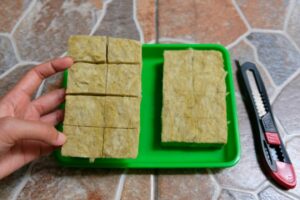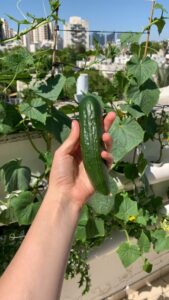Choosing the right growing medium is crucial for the success of your hydroponic plants. Of the many options for growing media, Rockwool has become popular due to its excellent water retention and air circulation properties. Rockwool comes in various forms, such as blocks, cubes, and slabs, but the cube is the most common.
When setting up your hydroponic garden, determining the appropriate size of Rockwool cubes can be somewhat confusing. So to help you figure things out, we will explore the different factors to consider when selecting cube sizes and guide you to help you make informed decisions for your hydroponic set-up. So let’s dive in and discover the ideal Rockwool cube size for your plant’s growth and development!

What Rockwool Cube Sizes Are Available and When to Use Them?
When it comes to using Rockwool in hydroponics, there are several different sizes available to choose from. Here are some general guidelines:
Starter Plugs
Smaller rockwool cubes, often referred to as starter plugs, are commonly used for germinating seeds or rooting cuttings. These plugs are usually around 1 inch (2.5 cm) in size. They provide a good environment for establishing seedlings or developing root systems for cuttings before transplanting into larger growing media or hydroponic systems. The Legigo 1″ Rockwool Starter Plugs are a great option to start with.
Small to Medium Cubes
For young plants or small herbs, you might use rockwool cubes around 1.5 to 2 inches (3.8 to 5 cm). These cubes provide enough space for initial growth and root development before transferring the plants to a larger system.
Larger Blocks
When growing larger plants like tomatoes, peppers, or other vegetables, larger rockwool blocks can be used. These blocks can range from 3 to 4 inches (7.6 to 10 cm) and offer more room for extensive root systems to develop as the plants grow.
Custom Sizes
Depending on your specific needs and the hydroponic set-up, you can find rockwool cubes or blocks in various sizes, including custom sizes, to suit your plants and system design.
When selecting the size of rockwool cubes, there are a few factors to consider. They include:
Plant Size
Consider the size and stage of growth of your plants. Smaller plants or seedlings may require smaller cubes, while larger plants or those with extensive root systems may benefit from larger cubes.
Water Retention
Evaluate the water retention needs of your plants. Smaller cubes tend to dry out faster, which can benefit plants that prefer drier conditions. Larger cubes hold more water, making them suitable for plants that require consistent moisture.
Nutrient Availability
Consider the nutrient requirements of your plants. Smaller cubes might require more frequent nutrient solution applications due to their limited capacity, whereas larger cubes can hold more nutrients and provide a steady supply to plants.
Root Development
Think about the desired root development for your plants. Smaller cubes can encourage quicker root development and easier transplanting, while larger cubes allow for more root growth and the potential for longer-term growth in the same cube.
Space Constraints
Assess the available space in your hydroponic system. Smaller cubes are more space-efficient and can accommodate more plants per unit area, while larger cubes require more room but offer greater stability and support for larger plants.
Remember, the size of Rockwool cubes is not a one-size-fits-all solution. It’s important to consider these factors in combination with the specific needs of your plants to determine the most suitable size for optimal growth and performance in your hydroponic set-up. Experimentation and observation will help you determine the best cube size for your specific hydroponic set-up and plant requirements.

How to Prepare Rockwool Cubes for Hydroponics?
Before using rockwool in your hydroponics, you must prepare the growing medium. Here are a few steps to follow.
Before you start handling any rockwool, make sure to wear protective gear. Rockwool can irritate the skin, so gloves and protective clothing are recommended when handling it.
Soak the Rockwool
Start by sanitizing the cubes. One method is to rinse them with steam or boiling water. This helps to kill any bacteria present and ensures a clean growing environment. Once sanitized, place the Rockwool cubes in a clean container.
Fill it with pH-adjusted water (ideally around pH 5.5 to 6.5) to thoroughly saturate the Rockwool. The water should be at room temperature. Allow the Rockwool to soak for several hours or until it is completely saturated. You can gently press down on the Rockwool to ensure it’s evenly soaked.
Drain Excess Water
After soaking, allow the Rockwool to drain any excess water to be released. This will help prevent overwatering when you transplant your plants.
Adjust the pH
Test the pH of the Rockwool with a pH testing kit or pH meter. The ideal pH range for hydroponic systems is generally between 5.5 and 6.5.
If the pH is too high or too low, adjust it by soaking the Rockwool in water that has been pH-adjusted to the desired range. Allow the Rockwool to absorb the adjusted pH water. This step helps dissolve any lime present in the Rockwool cubes.
Add the nutrient solution
If your hydroponic system requires a nutrient solution, you can mix a diluted solution according to the manufacturer’s instructions. Gently pour the nutrient solution onto the Rockwool cubes, allowing them to absorb the solution.
Ensure the nutrient solution adequately submerges or irrigates the root zone but does not oversaturate the cubes. Rockwool retains moisture well. You might also want to soak the Rockwool in a fungicide solution for about 30 minutes to eliminate any potential bacteria or fungus.
Germinating Seeds
Create holes or depressions in the Rockwool cubes or blocks to accommodate your plant starts, seeds, or cuttings.
Place your plant starts or seeds in the prepared holes and gently press the Rockwool around the roots to secure them.
Monitor and Adjust
Regularly monitor the Rockwool’s moisture level, pH, and nutrient levels. Adjust watering and nutrient application as needed based on the plant’s growth and specific hydroponic system requirements.
Following these steps will help you properly prepare Rockwool for use in your hydroponic system, providing a suitable growing medium for your plants to thrive.
Remember, it’s always important to follow the specific instructions provided by the manufacturer of the Rockwool product you are using, as preparation methods may vary slightly.

Do’s and Don’ts of Using Rockwool Cubes in a Hydroponic System
When using Rockwool cubes for hydroponics, it’s essential to keep in mind some do’s and don’ts to ensure successful plant growth. Here are some tips I found:
Do’s
- Pre-Soak: Before use, pre-soak the Rockwool cubes in pH-adjusted water to ensure they are properly hydrated.
- Maintain Proper pH: Regularly monitor and adjust the pH of your nutrient solution to ensure optimal nutrient uptake by the plants.
- Provide Adequate Drainage: Ensure that the Rockwool cubes have sufficient drainage to prevent waterlogging and promote healthy root development.
- Keep Air Flow: Allow for adequate air circulation around the Rockwool cubes to prevent the growth of mold or fungal diseases.
- Monitor Nutrient Levels: Regularly check and adjust the nutrient levels in your hydroponic system to provide the right balance of essential elements for your plants.
- Follow Manufacturer’s Instructions: Always refer to the specific instructions provided by the manufacturer of the Rockwool product you are using for best practices.
Don’ts
- Rely Solely on Rockwool for Nutrients: Rockwool is inert and does not provide any nutritional value to plants. Ensure you provide a suitable nutrient solution for your hydroponic system.
- Overcrowd Rockwool Cubes: Avoid placing the Rockwool cubes too close together, as it can hinder airflow and lead to poor plant growth.
- Reuse Damaged Cubes: Smaller Rockwool cubes may break down and become unsuitable for reuse. Instead, consider repurposing them in compost or outdoor gardening.
Remember, these tips serve as general guidelines, and it’s important to consider the specific instructions and recommendations from the manufacturer of your Rockwool cubes for optimal results.

What Can I Grow With Rockwool Cubes?
When Rockwool cubes as a growing medium, there is a wide range of plants and crops that can be successfully grown. Rockwool provides excellent water retention, proper aeration, and support for plant roots. Here’s some detailed information on utilizing Rockwool cubes for germination and growth, along with ideal growing conditions:
Plant Selection
- Leafy Greens: Lettuce, spinach, kale, arugula, and other leafy greens thrive in Rockwool cubes.
- Herbs: Basil, parsley, mint, cilantro, and other herbs can be grown effectively in Rockwool.
- Vegetables: Cucumbers, tomatoes, peppers, eggplants, and other small to medium-sized vegetables adapt well to Rockwool.
- Flowers: Certain flowers like roses, orchids, and gerbera daisies can be grown successfully in Rockwool.
- Microgreens: Rockwool is often used for starting microgreens. These young, edible plants are harvested at an early stage and are packed with flavor and nutrients.
Ideal Growing Conditions
- Temperature: Most plants prefer temperatures between 65°F (18°C) and 75°F (24°C). However, specific temperature requirements may vary between plant species.
- Humidity: Maintain a relative humidity level of around 40-60% for optimal plant growth. Adjust as needed based on the specific plant’s requirements.
- Light: Provide adequate light based on the plants being grown. Most plants require around 12-16 hours of light per day. Use appropriate grow lights or natural sunlight for photosynthesis.
- Watering: Keep Rockwool cubes evenly moist without waterlogging. Monitor moisture levels regularly and water accordingly based on the plant’s needs.

Steps for Germination and Growth
- Pre-soak the Rockwool cubes in pH-adjusted water for a few hours or overnight.
- Place seeds or seedlings into small holes or slits on top of the cubes. Ensure good contact between the seeds and the Rockwool.
- Place the cubes in a tray or container with adequate drainage to prevent waterlogging.
- Maintain proper environmental conditions, including temperature, humidity, light, and air circulation.
- Provide a balanced nutrient solution that matches the plant’s growth stage. Follow the recommended nutrient dosage and pH levels.
- Regularly monitor the moisture levels in the Rockwool cubes and water when necessary to prevent drying out.

Tips and Tricks for Success
- Use a propagation dome or plastic wrap to create a greenhouse effect for higher germination rates.
- Monitor and adjust pH and nutrient levels regularly to ensure optimal plant health.
- Prune and train plants as needed to maximize productivity and encourage healthy growth.
- Consider using a support system like trellis netting for vining plants like cucumbers and tomatoes.
- Implement proper pest and disease management techniques to maintain plant health.
Drawbacks of using rockwool
While Rockwool has many benefits, there are a few drawbacks to consider:
- Handling Rockwool can irritate the skin, so wear gloves and protective clothing during set-up.
- Rockwool is not biodegradable and can contribute to waste accumulation.
- Alternative growing mediums include coco coir, perlite, vermiculite, and even soilless mixes like hydroton or clay pebbles. Each medium has its advantages and may be better suited for specific plants or applications.
Remember, it’s crucial to research the specific requirements of the plants you intend to grow to optimize their health and productivity.
Conclusion
Choosing the right size of Rockwool cubes is crucial for successful plant growth in hydroponics. It’s essential to follow the manufacturer’s recommendations for the specific Rockwool product you are using. They may provide guidelines on cube size based on the intended application.
Ultimately, the size of the Rockwool cubes you choose should align with the needs of your plants and the constraints of your hydroponic system. By taking into account plant size, space efficiency, water retention, nutrient availability, and flexibility, you can make an informed decision and set yourself up for successful and thriving hydroponic gardening.






